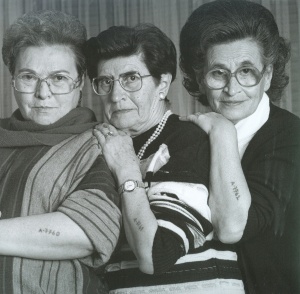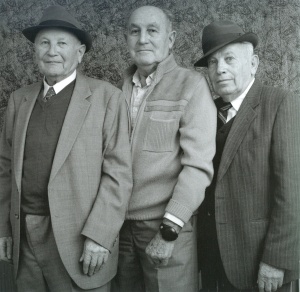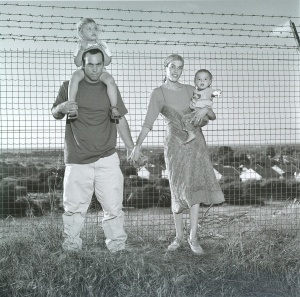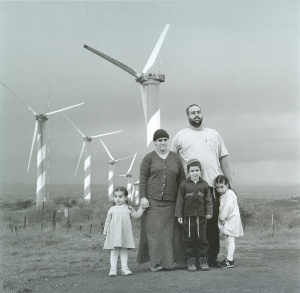Photographs of Vardi Kahana

The Holocaust was “Ground Zero of the Greenwald-Kahana family.” In the midst of the murderous fury of 1944 three sisters were tattooed with consecutive numbers in Auschwitz. They were lucky; they survived while so many of their family perished. The sisters found their way to Israel where they met men, married, had children who had children who will have children. They have rebuilt the Jewish people from the ashes and one talented offspring, Vardi Kahana, born in 1959, has documented the history of her diverse family over the last 15 years. Four generations slowly emerge from her majestic photographic essay of close to 100 black and white photographs, captured in a book published by the Tel Aviv Museum of Art, many of which were shown recently in New York at the Andrea Meislin Gallery. This series of photographs is called One Family and yet is a telling portrait of the contemporary Jewish people, the Israeli experience writ large, “the entire spectrum [that] comes to represent Israel in its current, multifaceted reality.”
Vardi Kahana possesses a visual intelligence that illuminates the majority of her photographs. Her extensive photographic work in newspapers and periodicals finally led to the position of editorial photographer for the weekend magazine of Yedioth Ahronoth that she has held since 1995. She recently had a solo exhibition at the Tel Aviv Museum of Art and has shown in many group exhibitions including many international venues and the Israel Museum. Her closely studied portraits are a veritable who’s who of Israeli political, entertainment, sports and artistic leadership. From prime ministers, IDF Chief of Staff, and politicos to poets, actors and authors, the entire spectrum of Israeli leadership has come under the scrutiny of her lens. Whether shot in her studio or in carefully chosen locations, each portrait manages to penetrate the personality of the sitter even as it preserves and forcefully expresses, through exquisite composition and lighting, their public role.
She did not hesitate to use her considerable skills when she decided to document her family in 1992. She started with her mother, Rivka and her two sisters, Leah and Esther. While the tattooed numbers, A-7760, A-7761 and A-7762 become the defining motif linking the photograph with a terrible past, it is the intense gaze of the three sisters, each different in character and equally transfixing, that brings this image into the inescapable present.

Quickly thereafter she photographed her father Aharon and his two brothers Moshe and Yehezkel, all three of whom had escaped Europe before the war. Their image is less riveting and yet the compositional strategy of two suits and two hats framing the hatless Moshe provides a mini-narrative of sibling camaraderie and distinction. The common history of the 3 brothers and 3 sisters, and the fact that all had come from the town of Beregszaz, Hungary, made them the natural foundation of a new clan transported to the safe haven of Israel. As one moves through the exhibition and more extensive photographs in the book it becomes obvious that Kahana has documented not a typical snapshot family history of births, celebrations and deaths; rather the diversity of Israel itself emerges as a historical and sociological process.
Pointedly each photograph locates where the family member was portrayed. Each link expands the restless dispersion of the family from the original six founders. We see no less than thirty different locations that these four generations call home in Israel, not to mention other family members in Denmark and the Netherlands.
In the Shomron they include Ateret, Alfei Menashe, Kiryat Sefer, Psagot, Maaleh Michmash and Nofei Prat. The Tel Aviv area is represented by Petach Tikva, Ramat Hasharon, Neve Tsedek, Bnei Brak and Ramat Gan. Some of the family is in Hebron, Susya and Arad while in the north they are found in Safed, Meron, and Kibbutz Lehavot Habashan in the Hula Valley. Along the northern coast their relatives are in Kibbutz Cabri near Nahariya, Kfar Masaryk near Acco and Kiryat Bialik in Haifa. Further south they are found in Karkur, north of Hadera, Caesaria, Herzliya, Savyon and Moshav Hagor near Kfar Sava. Finally some family members who used to be in Ganei Tal in Gaza were photographed before the expulsion.
Surveying this far-reaching map of family members reveals that Kahana’s project is as much about geography as photography. And of course in Israel geography instantly translates into ideology and theology. Vardi Kahana’s family ranges from pierced and tattooed secular individuals to religious Zionist and Haredi families. The viewer becomes uncomfortably aware of which images we associate with and which images we reject or condemn because they don’t fit our ideals of Israeli life. Once we see them, though, we cannot erase them and therefore they challenge our notion of the ideal with the real. All from one family.

One image captivates us by its disparity. “Malki, cousin Yaki’s daughter, with her husband Oren and their children Shira and Eyal” at Ganei Tal, Gush Katif. Here this attractive young woman, her husband and their young two children pose before a barbed wire fence, one that at first glance they are on the outside of. The fence separates them from their dangerous neighbors and yet, why are those houses on the other side so nice and, after all, which side are they on?

Other relatives present other views. “Yehuda, cousin Eta’s son, with his wife Renat and their children Uri, Hallel and Adi” are seen near their home at Alonei Habashan on the Golan Heights. They stand without a fence, this family of five proud Jews before the five modern windmills that seem to frame them, to protect them even as we know that the Golan, too, is politically vulnerable. Again Kahana’s compositional skill is evident as the size relationships between their three children (two little girls, one older boy), the middle-sized mother next to a rather tall and substantial husband Yehuda are directly echoed by the differently sized and positioned windmills. These photographs don’t just happen, they are carefully posed, positioned and cropped to make them visually narrate.
Vardi Kahana has created a far-reaching sociological portrait of the Israeli Jewish people through the lens of her own extended and diverse family. There are far too many intelligent, artful images of secular, traditional, yeshivish, and Haredi family members to do justice to the powerful scope of this project.
Just as the covenant of Torah and Land to the Jewish people was finally fulfilled not by lone individuals but rather through Jacob’s family; Kahana’s One Family suggests that contemporary Israel and the Jewish people will be built up and sustained by the vitality and diversity of the Jewish Family. These powerful photographs are living proof of this reality.
One Family: Photographs of Vardi Kahana
Selected Images: Columbia / Barnard Hillel
The Kraft Center for Jewish Student Life
606 West 115th Street (Broadway)
Andrea Meislin Gallery, 526 West 26th Street, #214;
Kahana’s work at vardikahana.com